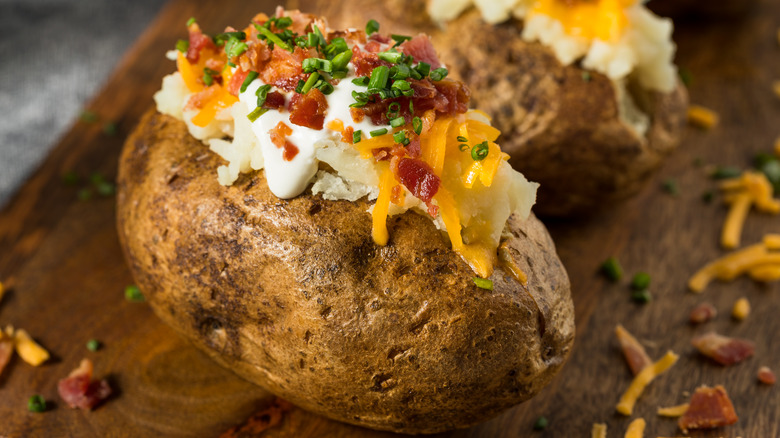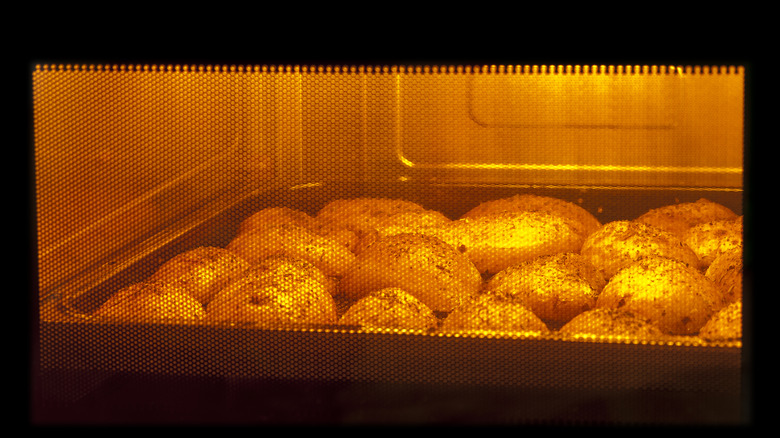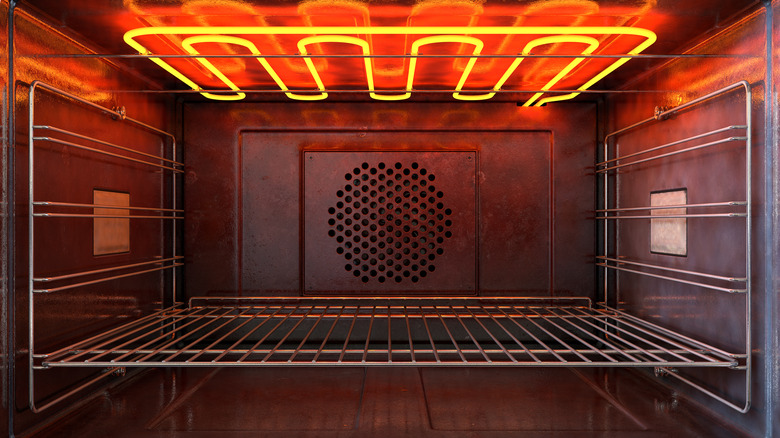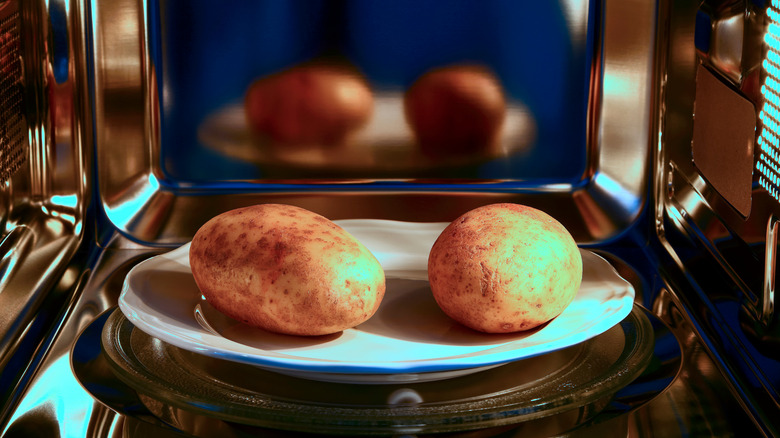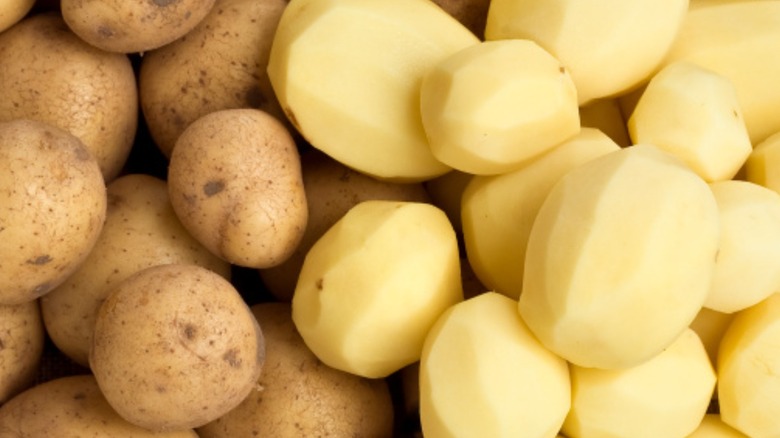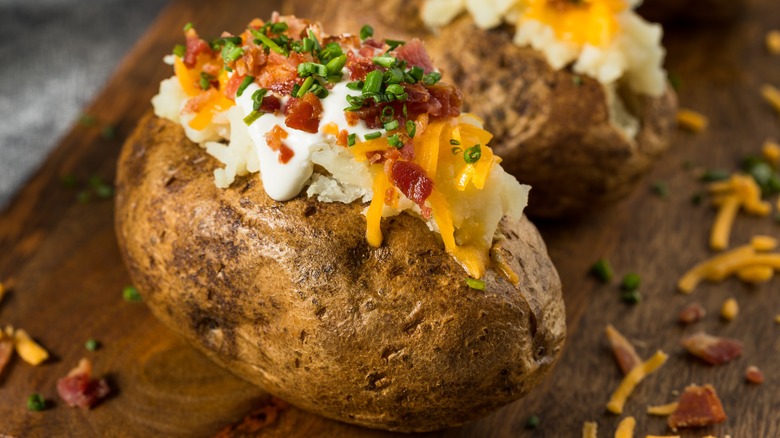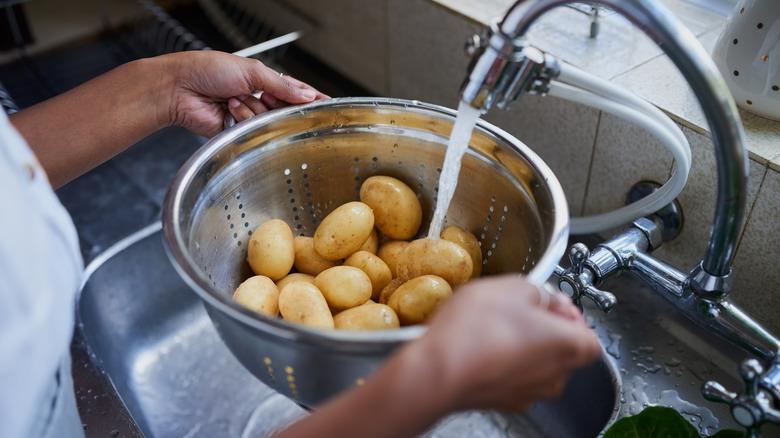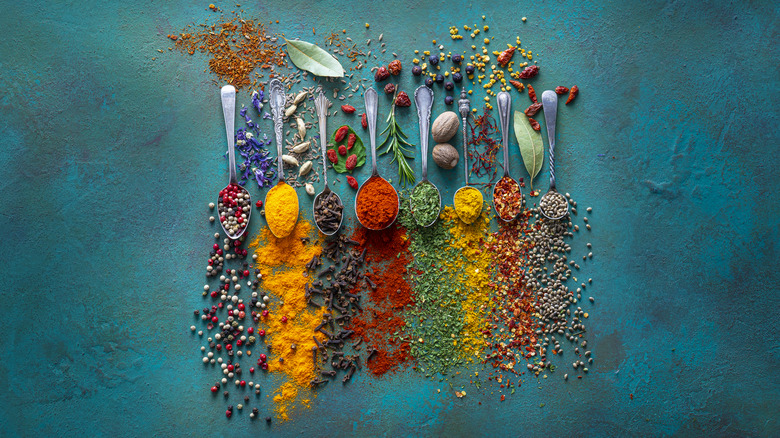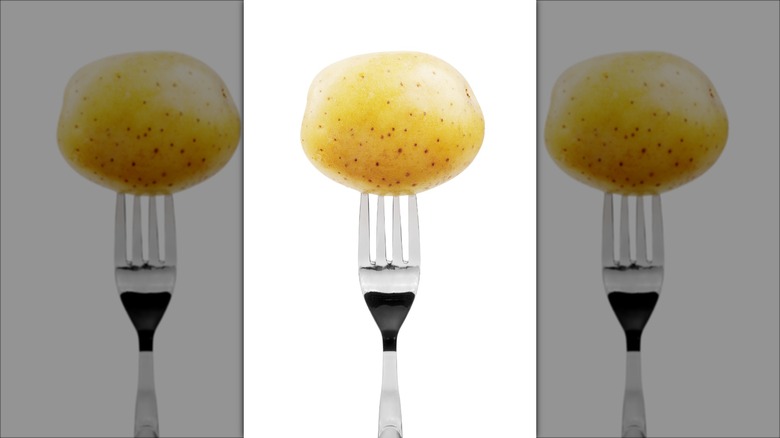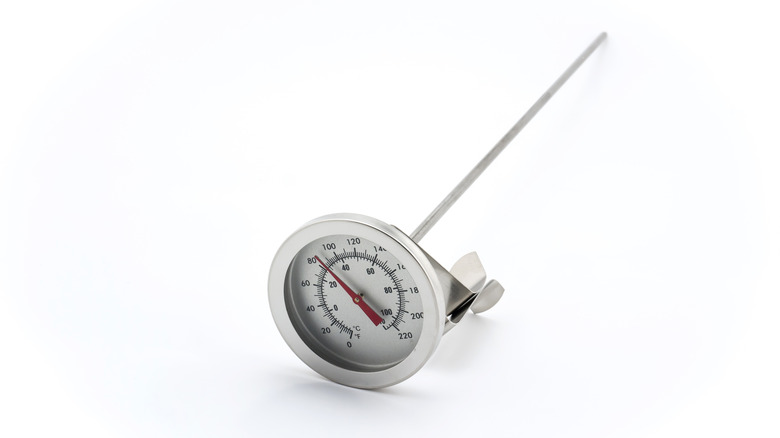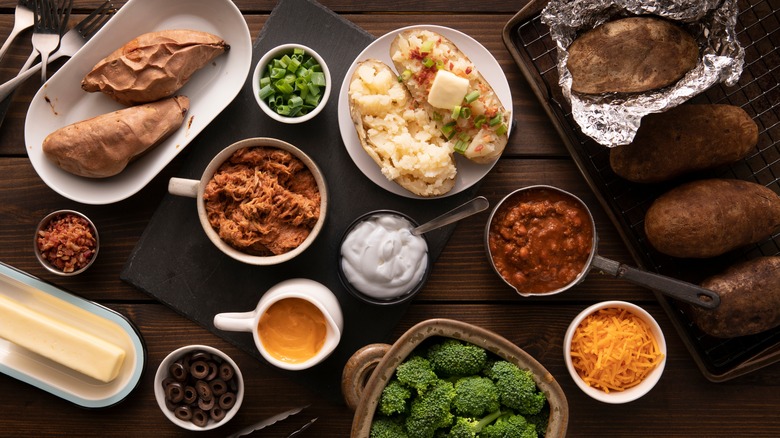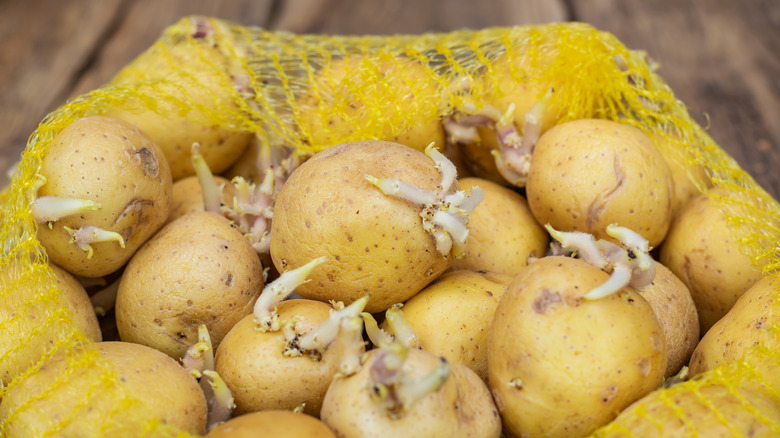13 Mistakes That Lead To Bland Baked Potatoes
As far as comfort foods go, it's hard to beat a good baked potato. Cut it open, and a fluffy white, tater-y steam wafts up to your nostrils inducing the kind of involuntary mouth-watering action that only a supreme spud can. It's hard to imagine screwing up such a perfect food, but for the uninitiated foodie, this staple item often isn't a beauty to behold but a bland baked potato. Much of this response comes down to the mistakes the inexperienced make with their favorite tubers.
Blame it on the fact that baked potatoes are kind of like the blank canvases of the vegetable world. On the most basic level, a baked potato consists of a starchy white interior that needs a little TLC to make it come to life on your taste buds. Otherwise, it remains bland and mostly, difficult to tolerate given the lack of flavor and tongue-drying texture that comes along with unadorned taters.
Toppings, seasonings, cooking times, budget constraints, and even potato types all lend themselves to the overall experience you have when it comes to building the best baked potato. Not knowing how each of these elements affects baking potatoes leads to cooking mistakes and can rob you of the spud you dreamed of when you began cooking. In this piece, you'll learn about some those mistakes, any of which can lead to bland baked potatoes. More importantly, you'll learn what you can do to avoid them.
1. Not using the best potato for baking
When it comes to choosing the best potato for baking, go for the starchiest potato you can find. It is, in fact, the potato's starch levels that determine how fluffy the spud is on the other side of baking. The tater's starchiness breaks down readily in the heat of the oven. Potatoes with less starch develop a creamier interior, which isn't exactly right for a baked spud that you'll fill with wet ingredients, like butter and sour cream. There's less starch to absorb the liquid in these toppings. Generally speaking, popping a starchier potato into the oven, like an Idaho Russet, presents you with the best options from both a taste and texture perspective. Long white potatoes also work well as baking potatoes, though they fall into a more medium-starchy category than their russet-y friends. The same can be said for Peruvian potatoes and even sweet potatoes as far as starch content is concerned.
Incidentally, this is also why a baked potato, like a russet, isn't the best option when you whip up a potato salad recipe for an afternoon picnic. Russet or Peruvian spuds fall apart, usually, due to their crumbly high starch interior. Meanwhile, red potatoes, aside from looking gorgeous in cold spud dishes, should be your potatoes of choice for salad recipes.
2. Opting to bake potatoes in foil
Baked potatoes engulfed in heavy blankets of foil are so ubiquitous that many tater lovers believe you must wrap a baked potato in foil to get a good bake on. This is simply not the case. Restauranteurs took to this trick because it allowed them to use blemished, possibly warty potatoes rather than toss them. It was all in the name of budget. The taste and texture of the potato came in second to budget, and many people have been baking them wrong ever since.
When you bake potatoes in foil, the foil functions as a shield, keeping the spud's moisture inside of the potato, instead of allowing it to escape. This leaves you with a soggy spud instead of a tater that has the light, fluffy interior and crisp baked potato exterior that makes the spud a standout. If you must give your spuds a good wrap, wait until they're completely cooked. Covering them in foil for a short time will keep them warm, but don't keep them wrapped for long. In this case, the foil functions as the tater's own personal warming drawer until you can serve it.
3. Not placing the spuds on the oven rack
If you bake potatoes on a baking sheet, consider separating the potatoes from the baking sheet by placing the spuds on the wire rack. (You'll still use the baking sheet, but more on that in a bit.) Baking your potatoes on the oven rack puts your spud in more direct contact with the heated air in your oven. This speeds up the baking process. When you put your taters on the oven rack, you make it easier for the heated air to circulate in and around your oven-nestled spuds.
There is a danger that the moisture inside the spud will drip out of the potato and into the bottom of the oven if you do try this trick. This is where the baking sheet gets reintroduced to the baking process. To prevent the spud's moisture from dripping down into the bowels of the oven, place the potatoes on the top oven rack and slide a baking sheet underneath on the bottom rack. This allows you to catch the spuds' drippings and keeps your oven clean while still allowing you to cook the potato on the rack.
4. Baking potatoes at 450 F or higher
While baking potatoes at 450 F seems like a good way to cook those spuds quickly, your spud will probably respond better to lower temperatures. Baking your taters at 450 F for over an hour leaves you with tubers that look more wrinkled than a shar-pei puppy's fur. Unfortunately, many home gourmands don't know that the spud's wrinkled texture comes from long cooking times and higher-than-necessary temperatures, causing them to repeat this baked potato mistake time and again. De-wrinkling your potato starts with lowering the oven temperature. Between 350 F 400 F does a much better job of cooking your spud, skin, and all.
The other challenge that you'll face is time. Baked potatoes turn out better when they stay in the oven for 55 to 60 minutes. When their internal temperature reaches 210 F all the way through, they're ready for sour cream (or sour cream substitutes) and chives.
5. Making a baked potato in the microwave
Making a baked potato in the microwave isn't quite the miracle you've been led to believe it is. Going the slow-burn route, so to speak, is definitely better here. You don't want to burn your tater to a crisp. However, you do want it to sit in your regular oven, allowing it to gradually heat up until the appliance's convection mechanism kicks in. When that happens, the starch granules free themselves from the confines of the spud's cell walls. If you want a light and fluffy interior through and through, this is practically guaranteed to do it. It's all about the chemistry of food.
It's also a matter of chemistry when your potato leaves the microwave with a series of hard spots punctuated with the occasional area of gooeyness. In this case, the granules of starch have burst wide open, leaving a potato that's dense, hard, and sticky. This is why you're left with a potato that's unevenly cooked at best and the makings of a doorstop at worst.
6. Undercooking the baked potato
Ending up with a potato that's not too raw and not too done is the baked potato equivalent of the Goldilocks story. To avoid an undercooked baked potato, you need to find the sweet spot that cooks the spud until it's fluffy but doesn't cook it so much it's wrinkled. Getting it just right is both an art and a science.
First, the potatoes must stay in the oven long enough for the machine's heat to permeate them thoroughly. This depends on how long they remain in the oven, as well as on the number of other items you have stashed in the oven alongside them. (Extra items can slow down cooking times.) Usually, this is an hour at least, though the exact cooking time can vary. Some ardent tater lovers even claim that three hours at 350 F makes for a most excellent potato. However, for some people, waiting three hours for a baked potato may seem a bit excessive even if it's guaranteed to taste good.
Second, short of taking a very long time to cook it at a lower temperature, there really is only one way to ensure your spud isn't undercooked when it leaves the oven. Check it with a thermometer or even the prong of a fork. If any part of it still feels raw, then leave it be.
7. Settling on cold baked potato toppings
Piping hot baked potatoes plus chilled toppings make for tepid taters. Granted, you don't want a dollop of sour cream on top after the creamy white stuff has been lounging on the counter for a fortnight. Room temperature is the happy medium. It's also the right level of warmness for your cold toppings, like sour cream, grated cheese, guacamole, and possibly salsa. They're still cool enough to avoid getting all melty and messy but warm enough to allow your tater to remain relatively cozy underneath it all.
Additionally, serving these toppings at room temperature does more than keep your spud warm. It also ensures that hot toppings, like steamed broccoli, bacon bits, steak shavings, and even a bonfire-inspired hot dog or two, remain hot enough to bring out the taste story that only a bit of heat can tell. And speaking of keeping ingredients hot, you may want to store items like steamed veggies or certain kinds of meats in containers that have lids. In some cases, a CrockPot may even be a better option for keeping your baked potato bar ingredients warm for the duration of the meal.
8. Not drying potatoes after washing them
Cleaning your baked potatoes before you cook them is a common step in the food prep ritual. The most thorough aspects of the ritual include a good scrub with a vegetable brush while dunking the spuds under some water for a few minutes. Pretty much all home chefs know they should wash their veggies, including their spuds, to rid them of any grime still left on them, but few may give much thought to drying.
However, not dabbing the excess moisture from the spud ensures that it'll get steamed in the oven instead of baked, particularly if you combine this part of tater prep with another baked potato mistake: Wrapping it in foil. As the Idaho Potato Commission points out, your spud consists of 80% water. Most of this usually evaporates in the oven during cooking. Any water left on the skin adds moisture to an already water-rich vegetable, making a steamed baked potato more likely than a baked one.
If it's a fluffy-as-clouds interior you're after, make sure the exterior of the spud is as dry as the desert dirt. If you have time to allow your spuds to air dry, your best bet is to lay your scrubbed spuds out on a rack or a colander until they have no more moisture on the skin. If you must dry them immediately after washing, use a linen cloth instead of a paper towel to avoid leaving fibers on the spud.
9. Seasoning your baked potatoes incorrectly
Seasoned baked potatoes are the antithesis of bland baked potatoes. If you do nothing else to buttress against such blandness, for goodness sake, at least get out the salt and pepper shakers, and maybe some garlic for good measure. Variations on this theme work, too, of course. Onion powder, basil, oregano, smoked paprika, chili powder, and the like all offer good options for seasoning baked potatoes. And if you'd like to try something a little out of the ordinary, adding cinnamon to your baked spuds adds a Middle Eastern flare to your meal.
You're also not limited to the potato's interior. If you want your spud to have some extra flavor, cover the skin with olive oil and add the seasonings to the skin. This has an added bonus: The olive oil on the skin makes it crisp. If you like a fluffy-on-the-inside, crispy-on-the-outside baked potato, this is the way to do it. There's no wrong way to do spices on your spud, except possibly leaving them off the potato altogether.
10. Not poking holes in the baked potato
In the right circumstances, baked potatoes will split their skins like the Incredible Hulk used to split his shirt when he morphed from human to gamma-ray greenie. Fortunately, all it takes to sidestep this eventuality is a fork and a few minutes. During that time, use said fork to pierce the spud's skin with a series of holes. The holes act like an open pressure valve does on a pressure cooker, releasing all the built-up steam inside the potato. No pressurized steam means no split potato skin. If the tines of your fork aren't strong enough to spike through the spud, the tip of a steak knife works, too. You just need enough sharpness to poke maybe eight or 10 holes into the potato.
There is one thing of note here: The skin doesn't always split if the potato has no holes. The faster the spud heats up, the more likely it'll split open, an event that happens more often in the microwave than it does in the convection oven. However, it's still a possibility in the oven, so if you're worried about it, go ahead and relieve the pressure inside the spud by adding some steam holes before you pop it in the oven.
11. Not checking baked potato temperature with thermometer
As a home gourmand, it's nothing to stake the interior of your steak with a cooking thermometer. As it turns out, your cooking thermometer should play an equally important role when you've got taters a-bakin'. A baked potato's internal temperature should fall between 208 F and 211 F, though you may also see temperature ranges, like 205 F to 212 F. In either case, you can be certain of the spud's temperature by using a cooking thermometer.
Naturally, you'll get the best reading by plunging the thermometer into the heart of the spud. The potato will likely cook from the outside in. That is to say, if you don't insert the thermometer deeply enough into the potato, you could get a false reading because the outer areas of the spud will be sufficiently cooked, but the inside won't be. If you've taken the tater's temperature and its internal temperature is now cooked enough for your taste, it's time to take the spuds from the oven and serve them. They don't need to sit like a steak does to be truly done.
12. Choosing boring baked potato toppings
A baked potato with a little butter and sour cream is a side dish. Add some ingredients, like broccoli, shredded cheese, mushrooms, olives, green onions, and other fixings, and your spud goes from a sort of bland side dish to a main meal in nothing flat. When choosing baked potato toppings, you can approach it in a couple of different ways. The smorgasbord approach allows you to combine ingredients like chili, shredded chicken, pulled pork, and barbecue sauce in one spread.
On the other hand, if you're having a theme party, like a Tex-Mex night, toppings such as black beans, queso, fajita veggies and meats, and different salsas make more sense. You're not limited to Tex-Mex as far as themes go. For example, an Asian-themed bar might include a variety of Asian sauces, like sweet and sour, hoisin, Szechuan, black bean, savory fish sauce, and General Tso's sauces. Kimchi, fried tofu, bamboo shoots, chopped bits of egg foo young, cream cheese-based crab stuffing for crab Rangoon, dry-cooked string beans, and sesame chicken are some of the toppings to try for this theme. Finally, from a thematic point of view, you're not limited to different world cuisines for inspiration. For example, you could hyper-focus on a type of food, like different types of cheeses or meats.
13. Roasting old potatoes
Aside from being just plain un-tasty, old and sprouted potatoes have the power to make you unwell. And while it's tempting to try and save your food budget by using the old potatoes in your cupboard, you potentially lose far more than you save in the long run. Chalk all of this up to the glycoalkaloid toxins that grow in green and sprouted potatoes.
In high concentrations, these toxins cause food poisoning, the symptoms of which are as scary sounding as the scientific name for the toxins. Tongue numbness, upset tummy, drowsiness, and confusion all count among the things that can possibly go wrong if you eat a potato with high concentrations of these toxins. As you might have guessed, the levels of the toxin go up the older the spud becomes.
But it isn't just green, sprouted spuds that you should concern yourself with. Potatoes that look like they're ready for the geriatric ward should be avoided, too. Basically, if they've begun to wrinkle, they've begun to rot. Once the decay process sets in, there ain't no amount of salt and pepper or anything else that's going to mask that yuckiness for long. Fresh potatoes make the best baked potatoes.
